The 3-4-3 system has made a resurgence lately, having been used by several top European teams in recent seasons.
For example, in the Premier League, Chelsea, Manchester City, Tottenham, and Nottingham Forest have all used the formation at some point.
It is a formation that allows for great flexibility; it can become a front five with attacking midfielders and wing-backs playing high on the opposition’s defensive line.
It can also be used to create a box midfield, providing an overload in central areas.
This tactical theory will provide a tactical analysis of how teams can attack in a 3-4-3.
Using examples from Pep Guardiola’s Manchester City, it will explore the flexibility of the system and provide several examples of how it can be used to create goalscoring opportunities.
This analysis will also offer suggestions on how coaches can implement these attacking tactics.
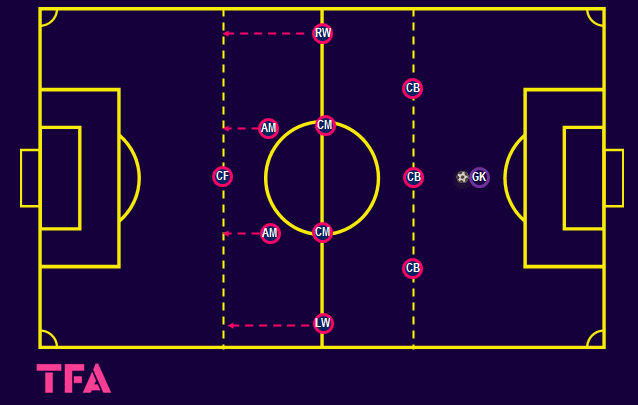
Typically, in the modern variant of the 3-4-3, the front three play narrow, with the two side forwards effectively becoming attacking midfielders.
The proximity of the three forwards allows them to combine with one another.
Another key advantage of the attacking midfielders’ positioning is it will enable them to make runs in behind the opposition’s backline.
These runs can be for long balls, or when the opposition’s back line becomes stretched, these midfielders can make runs in behind for through balls.
The box structure in the midfield allows teams to create a central overload and for the attacking midfielders to take up positions that are hard for the opposition to pick up.
Having three central defenders allows both wing-backs to go high, effectively creating a front five.
Corner runs
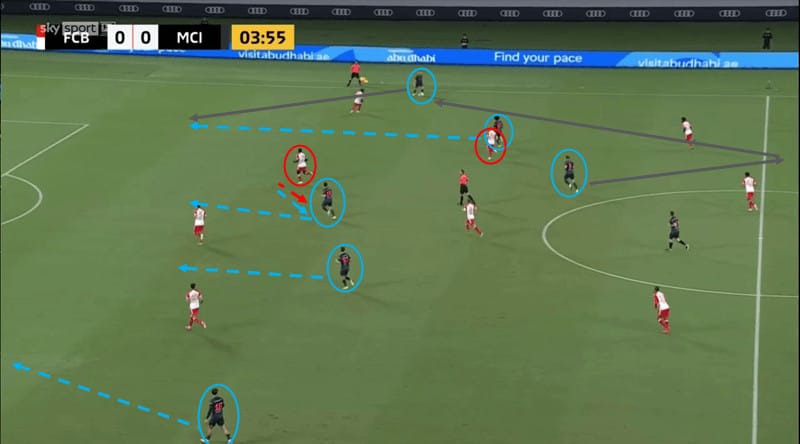
In the above example, from Manchester City’s pre-season match against Bayern Munich, City are in a 3-4-3 with both attacking midfielders in the pocket between Bayern’s defensive line and midfield.
The play started with City’s defensive midfielder on the ball.
The midfielder dropped the ball back to his side centre-back, who passed into his wingback’s- feet.
The wing-back received side on and played through his attacking midfielder, who had made a corner run between the centre-back and full-back.
Before the ball was played backwards to the centre-back, the striker had shown for the ball, making a diagonal run towards midfield across the left-centre-back.
The centre-back tracked the run, thus creating the space for the midfielders’ corner run.
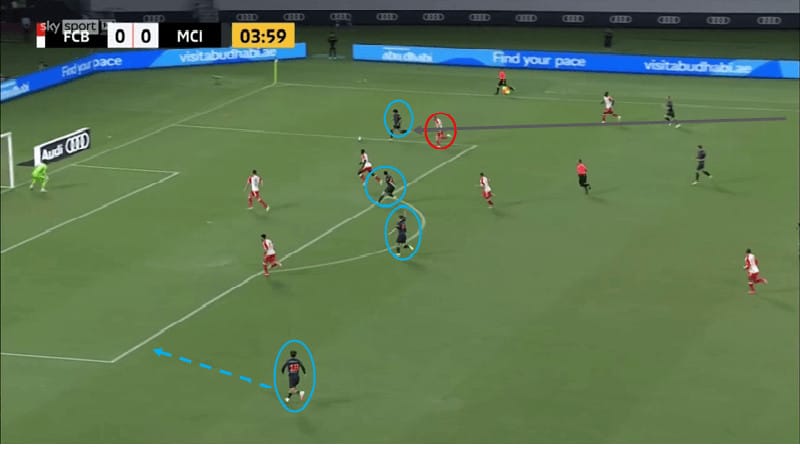
In this example of a corner run from the same match, the side centre-back attacks the space before playing in the attacking midfielder.
The wing-back being high, pins the opposition left-back.
The left-back is so preoccupied with preventing the wing-back from receiving the ball he is not even aware of the run being made behind him.
Again, the striker’s positioning between the centre-backs is paramount in creating the space for the attacking midfielder to run through.
Receiving in the pocket
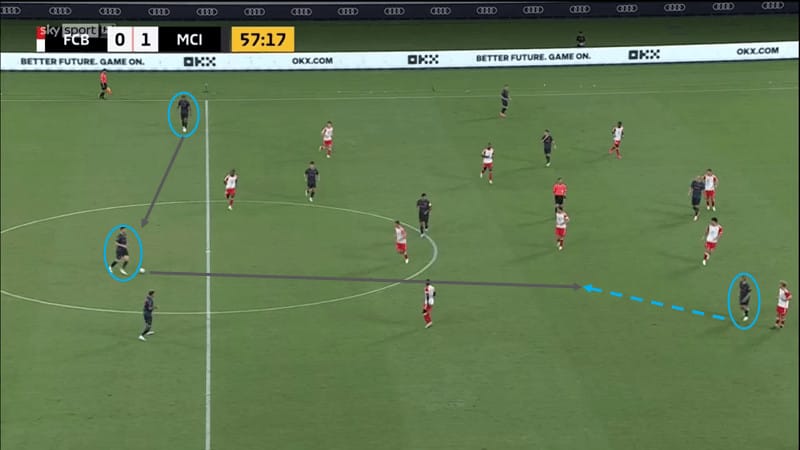
The above image shows City’s Bernardo Silva, after a switch of play, coming off Bayern’s backline to receive in the pocket.
Silva stays in front of the opposition’s left-back as the ball is switched across City’s backline.
Silva then darts into an area that leaves him both between the opposition lines and between the centre-back and full-back.
The awkward area in which he receives, and the presence of City’s high wing-back (out of shot), leaves the left back no choice but to drop off.
Haaland’s positioning prevents the ball-near centre back from stepping in.
Silva orientates his body so he can receive facing forward and immediately puts the opposition defenders on the back foot by dribbling at them.

Silva then plays in his wing-back before continuing his run between full-back and centre-back and into the box.
Silva receives the ball again in the cutback zone and puts the ball across the goal into a dangerous position.
Playing long
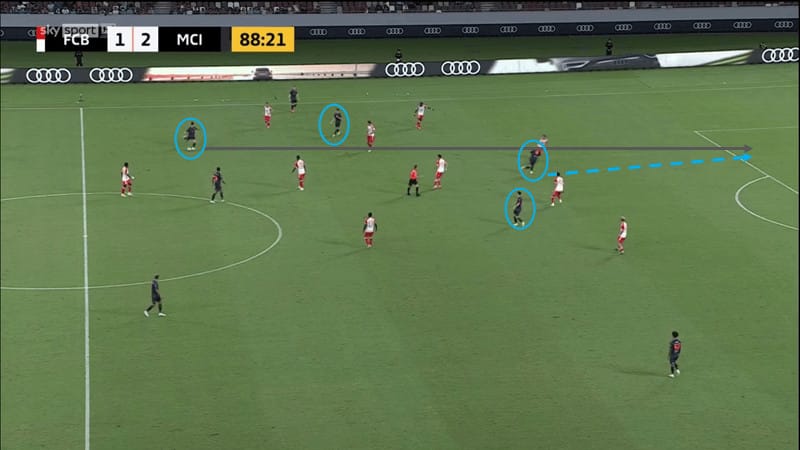
When the attacking midfielders pick up positions behind the midfield line, it creates a difficult decision for the opposition on how they squeeze that space.
It often encourages teams to play with a high line, especially when teams are wary of allowing creative attacking midfielders on the ball.
This gives teams the option of hitting the space behind the backline.
In the above example, the opposition’s backline have stepped up to deny the midfielders space, leaving only around six yards between the lines.
City’s solution is to simply hit the ball over the ball-near centre-back’s head for Haaland to run onto.
On other occasions, and as can be seen in the above scenario, the opposition’s backline is not only high but narrow.
This often leaves wing-backs in a position to receive long diagonals.
Finishing exercise in a 3-4-3
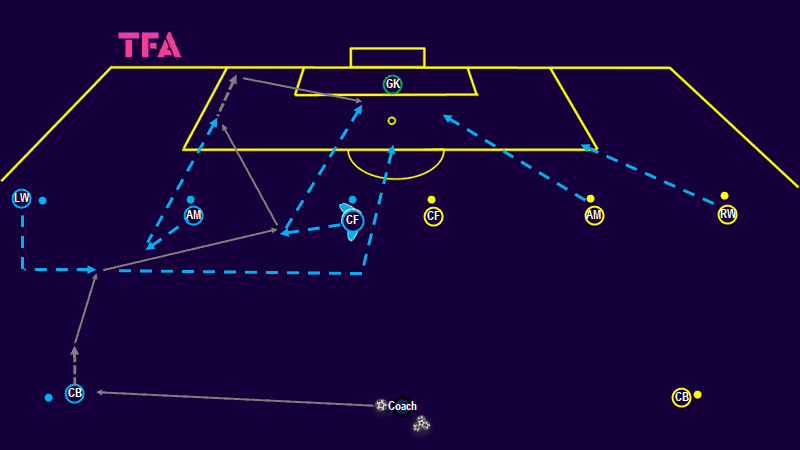
This shooting exercise is designed to simulate the front five being in advanced positions, on or near the opposition’s backline.
The front players combine to play a teammate in behind before a cutback is delivered.
The passing sequence goes down one side before being repeated down the opposite side.
After each repetition, the coach can decide if the players are to rotate through all positions.
Alternatively, the players can remain in their preferred playing position for the duration of the exercise.
The play starts with the coach (or extra player) passing to the side centre-back.
The centre-back attacks the space before triggering the pre-determined movements of his teammates.
For the first example, shown on the left of the pitch, the front players start flat, in line with one another.
They then make movements designed to create separation between defenders.
The first rotation shows the wing-back coming towards the ball to receive from his centre-back.
The centre-back plays the ball inside the wing-back.
This means the wing-back receives the ball facing inside the pitch, allowing him to see all his teammates and combine centrally.
As the wing-back receives, the attacking midfielder initially shows to receive the ball before spinning in behind.
The attacking midfielder is missed out, with the central forward receiving the ball facing side-on.
The forward then plays in the midfielder, who has spun in behind, down the side of the box.
The ball being fed through the defensive line is the trigger for all the front five to attack the box.
The left-wing back, whose run continued after passing to the striker, attempts to get to the penalty spot area.
The forward spins and attacks the front half of the second six-yard box.
The attacking midfielder and wing-back from the opposite side are also involved.
The midfielder attacks the ball-far half of the second six-yard box.
The wing-back is positioned in the far corner of the box.
This positioning allows the wing-back to pick up anything that is overhit.
It also allows the wing-back to attack the goal area should the other supporting forward players not be able to get there.
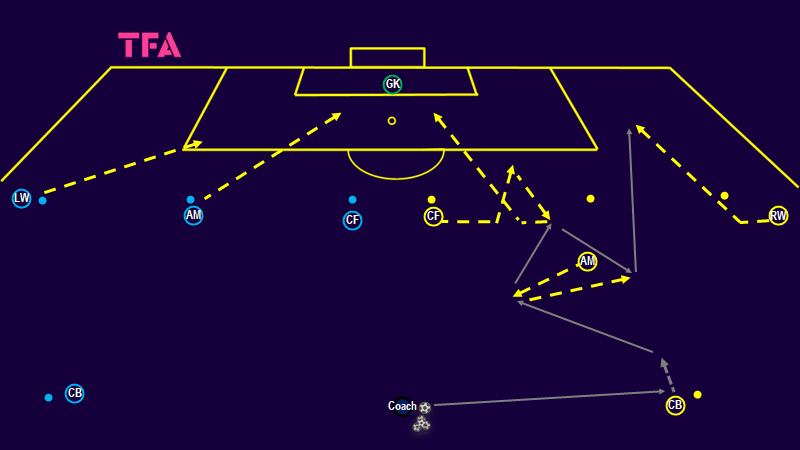
As shown on the right side of the pitch, the attacking midfielder is already positioned in the pocket.
The central forward makes an initial run in behind as the centre-back attacks the space.
This makes him a threat by potentially receiving a long ball, pushing back the opposition’s back line.
This allows the space for the attacking midfielder to receive alone.
The centre-back plays into the midfielder, who has made an angled run inside the pitch.
The midfielder receives with his body shape, allowing the following action to be forward.
The forward completes a double movement to receive to feet from the midfielder.
This could cause the opposition full-back to narrow, allowing the midfielder to play a one-two with the forward before playing in the right wing-back.
Phase of play
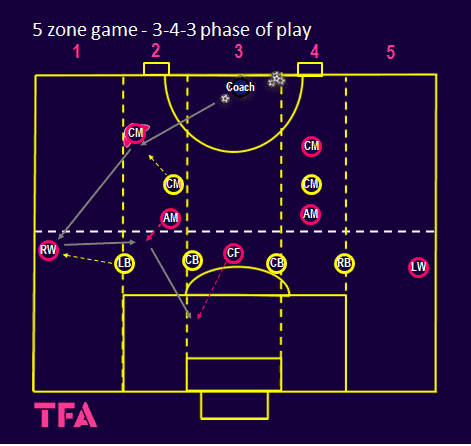
This phase of play exercise begins with an attacking team of seven against an opposition of 6 playing in one half of the pitch.
The attacking team (pink) attacks towards the goal.
The play starts with the coach feeding the ball into one of the attacking team’s central midfielders, where the game becomes live.
The pitch is divided into five lateral zones.
The attacking team sets up with two central midfielders and a front five consisting of a wing-back on each side, two attacking midfielders and a striker.
The front five must occupy five separate lateral lines in the buildup as they attack the goal.
When the ball enters the box, they are free to move.
The defending team (yellow) sets up with a back four and two defensive midfielders.
Depending on the desired outcomes of the coach, they can be provided with various ways to score.
In the above set-up, when the ball enters the final third, if the yellow team wins possession, they must progress it across the white line.
This encourages the pink team, particularly their front five, to counter-press and keep the defending team pinned in their defensive third.
The second way to score a point is for the yellow team to pass into the mini-goals or to the coach.
These are positioned on the halfway line across the three central areas to encourage the central midfielders to protect these areas on transitions.
When a goal is scored, the coach then restarts the play.
In addition to occupying each lateral zone, the attacking team should be encouraged to always be threatening in behind.
At least one of their front three should be making a run towards the goal.
This stretches the defending team and creates space between the lines.
The attacking midfielders, as well as occupying the half-spaces, should look to pick up positions between the opposition’s backline and midfield.
Whenever possible, they should receive with a body shape that allows them to play forward.
As with the shooting patterns, players should be given specific areas to attack when the ball enters the box.
A progression of the exercise can be for the coach to encourage combination play and positional rotations by allowing the front five to move between lateral zones.
When a player moves from one area to another, he should be replaced to keep the attacking team occupying as much of the width of the pitch as possible.
Conclusion
The 3–4-3 offers a good option for teams wishing to overload central areas.
It allows the front three to be close enough to combine and be a threat in-behind.
The positions these players can pick up leave opposition defenders with difficult decisions on when to close the space or to back off.
If positioned high, the wing-backs mean the team is still provided width.
Again, this gives the opposition defenders decisions on how much space to leave in the wide areas when attacking midfielders occupy the half-spaces.
From a defensive standpoint, having three centre-backs and two defensive midfielders gives the front five the freedom to attack without being overly vulnerable to a counterattack.






Comments